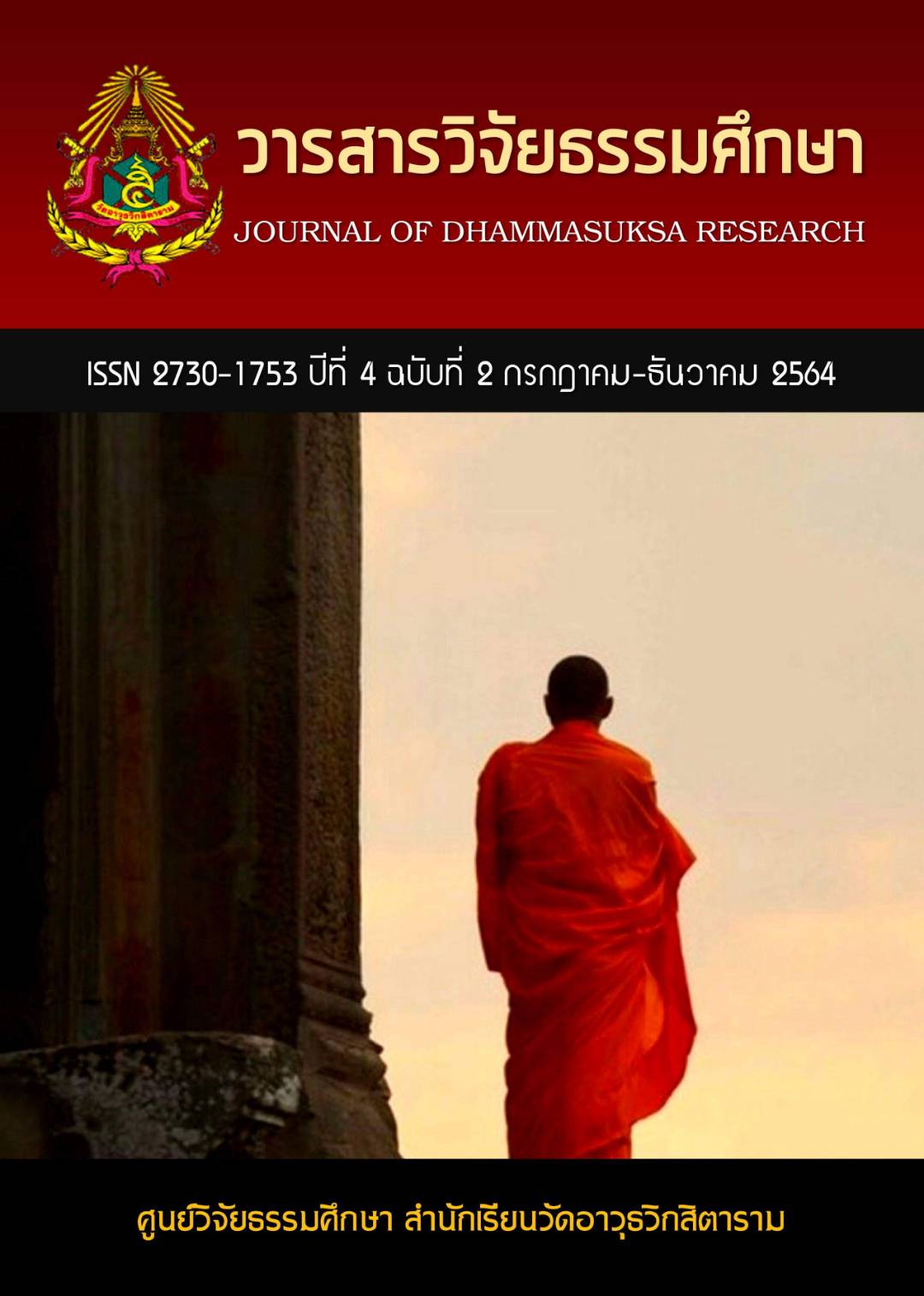การศึกษาเปรียบเทียบมนุษย์ในทัศนะพุทธปรัชญากับปรัชญาสางขยะ
คำสำคัญ:
เปรียบเทียบ, มนุษย์, พุทธปรัชญา, ปรัชญาสางขยะบทคัดย่อ
วิทยานิพนธ์นี้มีวัตถุประสงค์ 3 ประการ คือ (1) เพื่อศึกษาแนวคิดเรื่องมนุษย์ในพุทธปรัชญาเถรวาท (2) เพื่อศึกษาแนวคิดเรื่องมนุษย์ในปรัชญาสางขยะ และ (3) เพื่อเปรียบเทียบแนวคิดเรื่องมนุษย์ในพุทธปรัชญากับปรัชญาสางขยะ การวิจัยนี้เป็นการวิจัยเชิงเอกสาร
ผลการศึกษา พบว่า แนวคิดเรื่องมนุษย์ในพุทธปรัชญาเถรวาทถือว่ามนุษย์คือขันธ์ 5 ได้แก่ รูป เวทนา สัญญา สังขารและวิญญาณ เมื่อย่อลงมนุษย์คือกายและจิต พุทธปรัชญาเถรวาทมีทัศนะว่าชีวิตจะต้องตกอยู่ในทุกข์เพราะธรรมชาติของมนุษย์ตกอยู่ภายใต้กฎธรรมชาติ ความทุกข์เป็นธรรมชาติที่เกิดขึ้นจริงแก่มนุษย์ ความทุกข์มี 2 ประเภท คือ ความทุกข์ทางกาย ความทุกข์ที่เกิดขึ้นจากทางจิต สาเหตุสำคัญของความทุกข์คือความอยาก ดังนั้น พุทธปรัชญาเถรวาทจึงถือว่าการบรรลุนิพพานเป็นเป้าหมายสูงสุดของมนุษย์ เพราะมันทำให้ทุกข์ทั้งสองประเภทสิ้นไป แนวคิดเรื่องมนุษย์ในปรัชญาสางขยะถือว่าสรรพสิ่งเป็นการอิงอาศัยกันและกันของสิ่งที่เป็นอันติมสัจจะ 2 ประเภท คือ ปุรุษะและประกฤติ มนุษย์ มีองค์ประกอบ 2 อย่าง คือ ปุรุษะและประกฤติ ที่เป็นต้นเหตุ ให้เกิดการวิวัฒนาการของสิ่งต่างๆ รวมทั้งความทุกข์ด้วย หากมนุษย์สามารถรู้ถึงการแยกกันของปุรุษะและประกฤติอย่างสิ้นเชิงแล้วจะเป็นผู้ที่ถึงซึ่งความหลุดพ้น เมื่อถึงที่สุดของการตาย ไม่ต้องเวียนว่ายตายเกิดอีก วิญญาณจะกลับเป็นวิญญาณบริสุทธิ์ที่เป็นอมตะ เป้าหมายของมนุษย์ในปรัชญาสางขยะคือ การบรรลุโมกษะ คือต้องแยกปุรุษะออกจากประกฤติได้โดยเด็ดขาด ในการเปรียบเทียบแนวคิดเรื่องมนุษย์ระหว่างพุทธปรัชญาเถรวาทกับปรัชญาสางขยะ งานวิจัยนี้พบว่า ประเด็นที่เหมือนกันคือ แนวคิดทั้ง 2 มีทัศนะตรงกันว่า มนุษย์ประกอบด้วยสองส่วนที่เรียกว่า กายและจิต กายและจิตมีความสัมพันธ์กันทำให้เกิดชีวิต นอกจากนี้ยังพบอีกว่า หากมนุษย์ยังไม่สามารถบรรลุเป้าหมายของชีวิตได้มนุษย์ก็จะต้องเวียนว่ายตายเกิดอีก การที่จะบรรลุเป้าหมายของชีวิตได้จะต้องเข้าใจกายและจิตโดยมองว่ากายและจิตเป็นสิ่งที่อิงอาศัยกันไม่ใช่สิ่งเดียวกัน ประเด็นที่แตกต่างกันคือ พุทธปรัชญาเถรวาทมีทัศนะมองเรื่องจิตเป็นอนัตตาแต่ปรัชญาสางขยะมองจิตเป็นสภาวะที่เที่ยงแท้เป็นอัตตาเที่ยงแท้มีสภาวะเป็นนิรันดร์ นอกจากนี้ พุทธปรัชญาเถรวาทได้กล่าวว่าธาตุหยาบที่ประกอบในร่างกายของมนุษย์มี 4 ประเภท คือ ดิน น้ำ ไฟ ลม ส่วนปรัชญาสางขยะมองว่าในร่างกายมนุษย์มีธาตุหยาบ 5 ประเภท คือ ดิน น้ำ ไฟ ลม และอากาศ งานวิจัยนี้สามารถกล่าวได้อย่างมีเหตุผลว่า การศึกษาเปรียบเทียบนี้ทำให้เห็นว่าทั้งสองสำนักคิดล้วนพยายามทำความเข้าใจธรรมชาติของมนุษย์ การหลุดพ้นและหนทางที่จะหลุด
เอกสารอ้างอิง
พระไตรปิฎกภาษาไทย ฉบับมหาจุฬาลงกรณราชวิทยาลัย. (2539). กรุงเทพมหานคร : โรงพิมพ์มหาจุฬาลงกรณราชวิทยาลัย.
ประยงศ์ แสนบุราณ. (2547). ปรัชญาอินเดีย. กรุงเทพมหานคร: โรงพิมพ์ โอ.เอส.พริ้นติ้ง เฮ้าส์.
วไลพร ภวภูตานนท์ ณ มหาสารคาม. (2527). จิตวิทยาพุทธศาสนา. กรุงเทพฯ : เมดาร์ท.
สาโรช บัวศรี. (2556). จริยธรรมศึกษา. กรุงเทพมหานคร : โรงพิมพ์คุรุสภา.
สนธิ์ บางยี่ขัน. (2526). ปรัชญาไทย. กรุงเทพฯ : มหาวิทยาลัยรามคำแหง.
Horace Hayman Wilson, M.A.F.R.S.. Translated to English. (1887) The Sankhya Karika by ÍswaraKrishna. (Bombay: Printed at the Subodha - Prakash Press.
T.G. Mainkar. (1964). The Sāṁkhyakārikā of Īśvarakṛṣṇa. Translated into English and with Notes. (Poona - 2 (India): Oriental Book Agency.

ดาวน์โหลด
เผยแพร่แล้ว
รูปแบบการอ้างอิง
ฉบับ
ประเภทบทความ
สัญญาอนุญาต

อนุญาตภายใต้เงื่อนไข Creative Commons Attribution-NonCommercial-NoDerivatives 4.0 International License.


